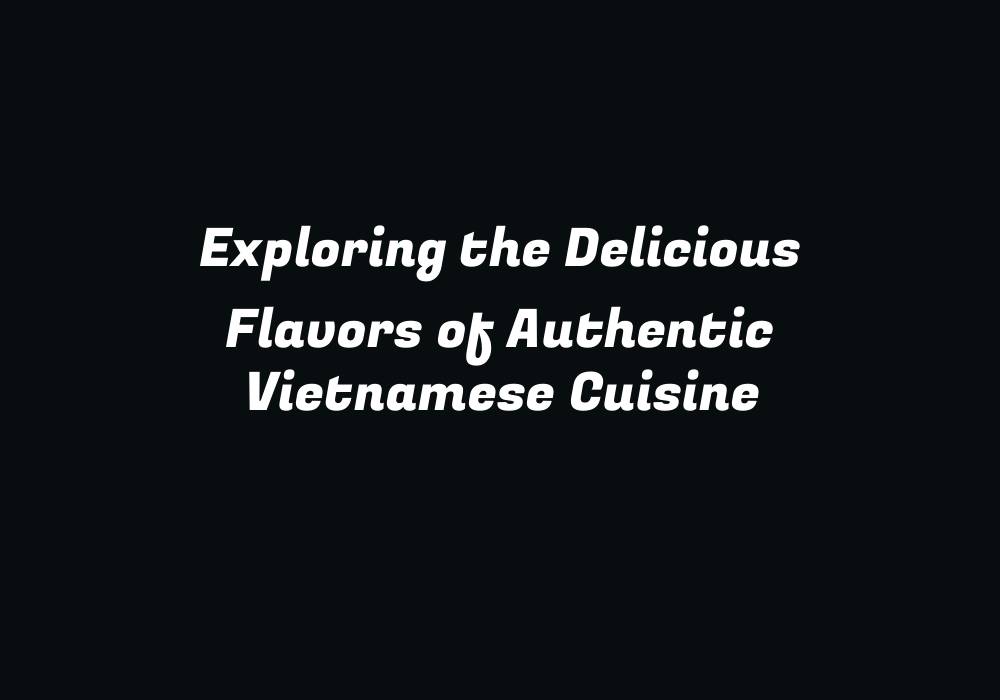Introduction to Authentic Vietnamese Cuisine
Vietnamese food is an intriguing blend of different culinary traditions, spanning across China, France, and Thailand. The fusion of these cultures has led to a diverse range of flavors that are unique to Vietnam’s gastronomic scene. From simple and hearty meals to delicate and complex creations, the Vietnamese cuisine offers an array of delicious dishes that can cater to almost every taste bud. In this article, we will explore some authentic and mouth-watering examples of this delectable culinary experience.
Phở: The Iconic Noodle Soup
The first dish on our list is the iconic Phở, a noodle soup that has captured the hearts of food enthusiasts worldwide. This fragrant and aromatic dish originated in Hanoi during the French colonial period, when rice noodles were introduced to Vietnamese cuisine. Phở is typically prepared with either beef or chicken, along with a medley of fresh herbs, spices, and other ingredients.
When making Phở, it is essential to prepare a rich stock that carries the distinct flavors of Vietnam. Traditionally, this broth is made using simmered bones from chickens or cows for hours, resulting in an intense and balanced taste. The noodles used in this dish are made from rice and have a delicate texture that complements the broth beautifully.
Bánh Mì: Vietnamese Sandwich
The next dish on our list is Bánh Mì, or Vietnamese sandwich. This popular street food has its origins in the French colonial period and is a perfect example of culinary fusion between two cultures. Bánh Mì usually features a crispy baguette, similar to those brought over from France. It is then stuffed with a variety of ingredients such as pork or chicken, pickled vegetables, fresh herbs like cilantro or basil, and a generous amount of spicy mayonnaise called “mayonnaise tây.”
The bread used for Bánh Mì is typically made from wheat flour and gives the sandwich its characteristic crispy crust. The combination of tender meats, fresh vegetables, herbs, and condiments creates an explosion of flavors in every bite. With its rich history and simple preparation, it’s no wonder that this humble sandwich has become a favorite among locals and tourists alike.
Bánh Cuốn: Steamed Rice Flour Rolls
Another quintessential Vietnamese dish is Bánh Cuốn, which translates to “soft pancake” in English. These delicate and fragile rolls are made from steamed rice flour batter, making them light and airy. They are typically served with a variety of fillings like minced pork and mushrooms, as well as a savory broth poured over the top.
Bánh Cuốn has its origins in the northern regions of Vietnam and is often enjoyed during breakfast. The combination of smooth rice flour rolls, tender meat filling, and the slightly sweet sauce creates a unique flavor experience that sets it apart from other Vietnamese dishes. To make the perfect Bánh Cuốn, it’s important to carefully monitor the steaming process and ensure that the rice flour dough remains thin and transparent.
Bún Chả: Grilled Pork with Vermicelli Noodles
Another classic Vietnamese dish is Bún Chả, which combines grilled pork marinated in a sweet-and-sour marinade, served alongside vermicelli noodles and an assortment of fresh herbs. The unique blend of flavors comes from the combination of various ingredients, including fish sauce, vinegar, sugar, garlic, and chili peppers.
The dish was once a humble street food but has since gained popularity as a beloved staple in many Vietnamese households. To prepare Bún Chả, the pork is grilled over charcoal or wood chips to give it a smoky and flavorful finish. The noodles are boiled until they’re al dente before being combined with the herbs, grilled pork, and sauce for an irresistible blend of textures and tastes.
Cơm Tấm: Breakfast Staple
Lastly, we have Cơm Tấm, a beloved Vietnamese breakfast dish that translates to “broken rice.” This simple yet satisfying meal originated from the southern region of Vietnam and is popular among all age groups. It consists of broken rice (which retains its texture after cooking), grilled pork chop, pickled vegetables, and fried egg served alongside fresh herbs like cilantro and basil.
Cơm Tấm is an excellent example of how Vietnamese cuisine can be both complex in flavors and yet so simple to prepare. The combination of different ingredients creates a symphony of textures and tastes, making it an ideal meal for those who appreciate the beauty in simplicity. It has become an essential part of the culinary landscape of Vietnam, representing its rich cultural heritage and love for delicious food.
In conclusion, Vietnamese cuisine is a fascinating blend of diverse culinary influences that have evolved over centuries to create unique dishes with distinctive flavors. From Phở to Bánh Mì, Bánh Cuốn to Bún Chả, and Cơm Tấm, each dish offers an unforgettable gastronomic experience that celebrates the essence of Vietnamese food culture. With its abundance of fresh ingredients, balance of flavors, and attention to detail, it is easy to see why Vietnamese cuisine has captured the hearts of food enthusiasts all around the world.
